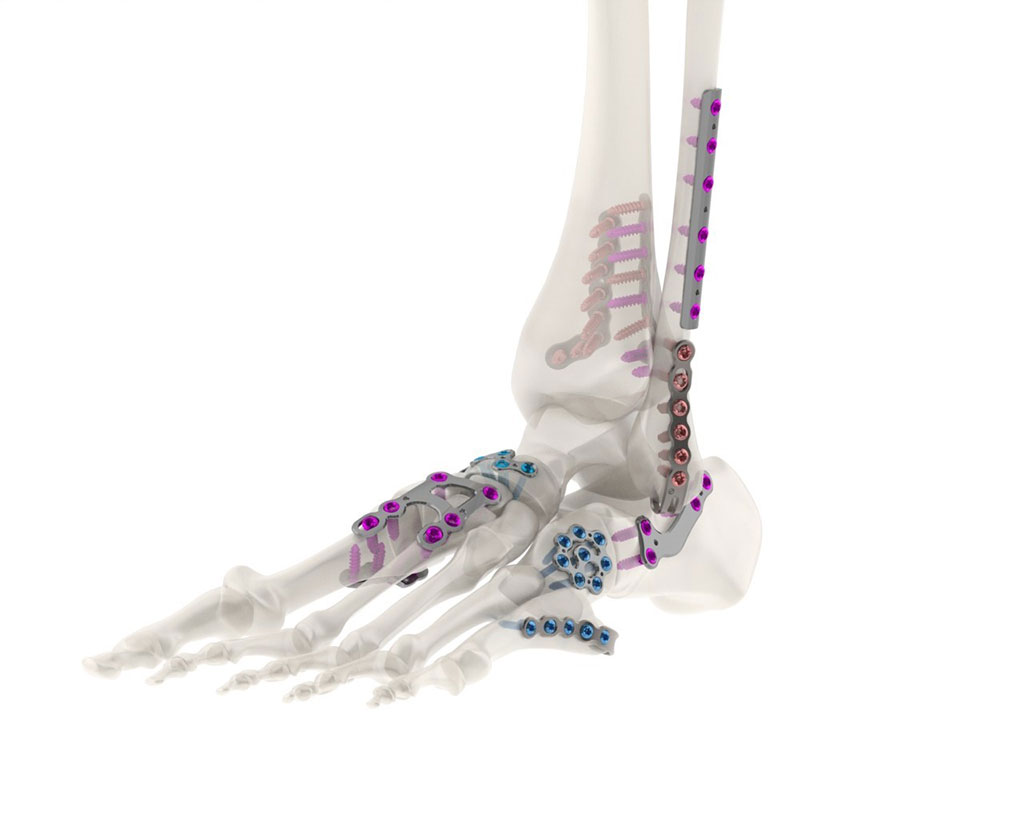Color Coded Plating Systems Ease Surgical Flow
|
By HospiMedica International staff writers Posted on 21 Sep 2021 |

A titanium plating system features color anodized parts for easy identification (Photo courtesy of Tyber Medical)
A comprehensive anatomic plating system addresses skeletal trauma and deformity procedures to the extremities.
The Tyber Medical (Morristown, NJ, USA) fixation device portfolio includes over 73 different indication-specific anatomical plating families, including Mini-frag/Small Bone, Long Bone Fracture, and Ankle Fracture/Fusion plates. All components made of titanium feature color anodized sections for easy identification of sizing and alignment with corresponding color-coded instrumentation. The system was developed using a combination of CT scans, clinical data, cadaveric labs, and consultation with industry-leading orthopedic and podiatric surgeons.
The Mini-frag/Small Bone plates, which includes stainless steel and titanium standard and variable locking compression plates and screws of varying lengths, thicknesses, and configurations, addresses the stabilization of fractures, osteotomies, joint fusions, non-unions, and fusions of small bones and bone fragments in the hand, wrist, foot, and ankle. The foot and ankle plating line are used in the fixation of medium/large bones, multi-fragment containment, as well as reconstruction and revision surgeries.
The Long Bone Fracture plates consist of a straight, low-contact locking plate and a 1/3 locking tubular plate. These plates, which incorporate hybrid cortical/cancellous threads featuring both variable angle locking and standard non-locking screws, are intended for osteotomies and non-unions and the fixation of fractures of the clavicle, scapula, olecranon, humerus, radius, ulna, and fibula.
The Ankle Fracture/Fusion System addresses indications in ankle reconstruction mid-shaft and distal tibia/fibula fixation surgery, with a variety of locking plate types for various fibula and tibia positions. Indications for this system include fixation of fractures of the distal tibia, including ankle fractures, intra-, and extra-articular fractures, osteotomies, medial malleolar fractures, and non-unions of the metaphyseal and diaphyseal region of the distal fibula, and calcaneus; and In distal tibia/fibula long bones.
Related Links:
Tyber Medical
The Tyber Medical (Morristown, NJ, USA) fixation device portfolio includes over 73 different indication-specific anatomical plating families, including Mini-frag/Small Bone, Long Bone Fracture, and Ankle Fracture/Fusion plates. All components made of titanium feature color anodized sections for easy identification of sizing and alignment with corresponding color-coded instrumentation. The system was developed using a combination of CT scans, clinical data, cadaveric labs, and consultation with industry-leading orthopedic and podiatric surgeons.
The Mini-frag/Small Bone plates, which includes stainless steel and titanium standard and variable locking compression plates and screws of varying lengths, thicknesses, and configurations, addresses the stabilization of fractures, osteotomies, joint fusions, non-unions, and fusions of small bones and bone fragments in the hand, wrist, foot, and ankle. The foot and ankle plating line are used in the fixation of medium/large bones, multi-fragment containment, as well as reconstruction and revision surgeries.
The Long Bone Fracture plates consist of a straight, low-contact locking plate and a 1/3 locking tubular plate. These plates, which incorporate hybrid cortical/cancellous threads featuring both variable angle locking and standard non-locking screws, are intended for osteotomies and non-unions and the fixation of fractures of the clavicle, scapula, olecranon, humerus, radius, ulna, and fibula.
The Ankle Fracture/Fusion System addresses indications in ankle reconstruction mid-shaft and distal tibia/fibula fixation surgery, with a variety of locking plate types for various fibula and tibia positions. Indications for this system include fixation of fractures of the distal tibia, including ankle fractures, intra-, and extra-articular fractures, osteotomies, medial malleolar fractures, and non-unions of the metaphyseal and diaphyseal region of the distal fibula, and calcaneus; and In distal tibia/fibula long bones.
Related Links:
Tyber Medical
Latest Surgical Techniques News
- Total Robotic Metabolic and Bariatric Surgery Proves More Beneficial than Conventional Laparoscopy
- Wirelessly Activated Robotic Device Aids Digestion in Patients with Compromised Organs

- Glowing Dye Helps Surgeons to Remove Hidden Prostate Cancer Cells in Real-Time
- Early Minimally Invasive Surgery Improves Intracerebral Hemorrhage Stroke Outcomes
- Early EVD Insertion Improves Surgical Outcome in Traumatic Brain Injury
- New Machine Learning Method Better Predicts Spine Surgery Outcomes
- New Research Platform Assesses Brain Cancer Mutations during Surgery
- Off-The-Shelf Surgical Device to Help Avoid Total Knee Replacement
- Study Warns Against Dangerous Smoke Levels Produced During Endoscopic Gastrointestinal Procedures
- New Hydrogel Sealant Effective at Sealing Dural Defects and Preventing Postoperative Adhesion
- MRI-Guided Multi-Stage Robotic Positioner Enhances Stereotactic Neurosurgery Precision

- AR Visualization System Improves Surgeons’ Capabilities and Spatial Awareness
- New Adhesive Hydrogel Coatings to Prolong Lifespan of Pacemakers and Medical Implants
- Maneuvering System Empowers Surgeons with Enhanced Control during Laparoscopic Procedures
- New Two-Dimensional Material Paves Way for Safer, More Effective Implantable Medical Devices
- Portable MRI Compatible Surgical Robot Improves Patients Outcomes for Neurosurgery
Channels
Critical Care
view channel
Ingestible Microbiome Sampling Pill to Help Diagnose Wide Range of Health Conditions
The healthy human gut is home to more than 1,000 species of bacteria, most of which play a beneficial role in digestion and protecting against disease. When the natural balance of these microbes is disrupted,... Read more
Breakthrough Computational Method Predicts Sudden Cardiac Death
Unfortunately, sudden cardiac death is often the first indication of heart disease, and it can strike even young, seemingly healthy individuals, particularly during intense physical activity.... Read more.jpg)
GPS-Like Smart Pills with AI Provide Real-Time 3D Monitoring Of Gastrointestinal Health
Gas produced in the intestines when bacteria digest food can provide valuable information about a person's health. Currently, to measure gastrointestinal (GI) tract gases, physicians use methods such as... Read morePatient Care
view channelFirst-Of-Its-Kind Portable Germicidal Light Technology Disinfects High-Touch Clinical Surfaces in Seconds
Reducing healthcare-acquired infections (HAIs) remains a pressing issue within global healthcare systems. In the United States alone, 1.7 million patients contract HAIs annually, leading to approximately... Read more
Surgical Capacity Optimization Solution Helps Hospitals Boost OR Utilization
An innovative solution has the capability to transform surgical capacity utilization by targeting the root cause of surgical block time inefficiencies. Fujitsu Limited’s (Tokyo, Japan) Surgical Capacity... Read more
Game-Changing Innovation in Surgical Instrument Sterilization Significantly Improves OR Throughput
A groundbreaking innovation enables hospitals to significantly improve instrument processing time and throughput in operating rooms (ORs) and sterile processing departments. Turbett Surgical, Inc.... Read moreHealth IT
view channel
Machine Learning Model Improves Mortality Risk Prediction for Cardiac Surgery Patients
Machine learning algorithms have been deployed to create predictive models in various medical fields, with some demonstrating improved outcomes compared to their standard-of-care counterparts.... Read more
Strategic Collaboration to Develop and Integrate Generative AI into Healthcare
Top industry experts have underscored the immediate requirement for healthcare systems and hospitals to respond to severe cost and margin pressures. Close to half of U.S. hospitals ended 2022 in the red... Read more
AI-Enabled Operating Rooms Solution Helps Hospitals Maximize Utilization and Unlock Capacity
For healthcare organizations, optimizing operating room (OR) utilization during prime time hours is a complex challenge. Surgeons and clinics face difficulties in finding available slots for booking cases,... Read more
AI Predicts Pancreatic Cancer Three Years before Diagnosis from Patients’ Medical Records
Screening for common cancers like breast, cervix, and prostate cancer relies on relatively simple and highly effective techniques, such as mammograms, Pap smears, and blood tests. These methods have revolutionized... Read morePoint of Care
view channel
POCT for Infectious Diseases Delivers Laboratory Equivalent Pathology Results
On-site pathology tests for infectious diseases in rural and remote locations can achieve the same level of reliability and accuracy as those conducted in hospital laboratories, a recent study suggests.... Read more
Cartridge-Based Hemostasis Analyzer System Enables Faster Coagulation Testing
Quickly assessing a patient's total hemostasis status can be critical to influencing clinical outcomes and using blood products. Haemonetics Corporation (Boston, MA, USA) has now obtained 510(k) clearance... Read more
Critical Bleeding Management System to Help Hospitals Further Standardize Viscoelastic Testing
Surgical procedures are often accompanied by significant blood loss and the subsequent high likelihood of the need for allogeneic blood transfusions. These transfusions, while critical, are linked to various... Read moreBusiness
view channel
BD Acquires Edwards Lifesciences' Critical Care Product Group for USD 4.2 Billion
BD (Becton, Dickinson and Company, Franklin Lakes, NJ, USA) and Edwards Lifesciences (Irvine, CA, USA) have entered into a definitive agreement under which BD will acquire Edwards' Critical Care product... Read more

















